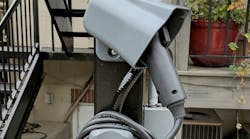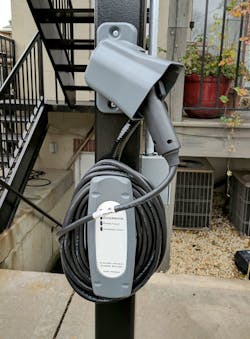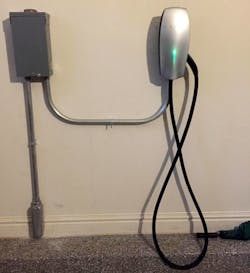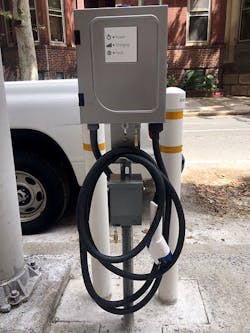“This is a big deal.” It’s noon on April 12, 2017, and Robert Monk is sitting in a West Philadelphia coffee shop, killing time between appointments. Six days earlier, the Philadelphia City Council voted 11 to 6 to place a moratorium on a decade-old program that allowed electric vehicle (EV) owners to reserve a parking space outside their home by installing a charging station at the curb, and Monk still can’t quite wrap his mind around the council’s logic.
“This wasn’t just something that made EVs possible here,” he says. “It worked as an incentive.”
Monk is a master electrician with Philadelphia-based Solar States, a contractor that specializes in residential and commercial photovoltaic (PV) installations. He’s also an outspoken opponent of the moratorium, which might not necessarily sound like a deterrent to purchasing a new Chevy Bolt until you consider that the vast majority of the city’s residents park on the street and must compete with one another for parking near their homes. Finding a spot can be challenging enough as it is. Finding one that also just happens to have equipment nearby capable of charging your EV overnight? Good luck.
“The fact is, you have to have a charger on your block if you’re considering buying an electric vehicle,” Monk says. Not only that, you have to have some assurance that the owner of a gas-powered vehicle won’t park in front of it.
Prior to joining Solar States in January 2015, Monk had his own electrical contracting business, which he’d turned into one of Philadelphia’s go-to installers for EV charging stations. He’s continued to provide the service since merging with Solar States, and he’s a firm believer that by 2020, 90% of new vehicles sold should be electric — and not just because it would mean more work for him. This moratorium, though? It has the potential to not only jeopardize that green future he dreams of, but also significantly slow down that side of the company’s business in the short term.
“Honestly,” Monk says, “I don’t know why anyone in Philadelphia would buy an electric car now.”
A politically charged debate
“We’re aware that in the short term, the moratorium could affect prospective EV owners,” says Matthew Pershe, a legislative aide for Philadelphia City Councilman David Oh, one of the co-sponsors of the moratorium. “The reserved parking program was a good early-adopter policy, but it wasn’t sustainable.”
Oh, who Pershe says has heard from numerous residents and neighborhood associations, has argued that the program unfairly favors EV owners by essentially turning a public resource into a private perk for those wealthy enough to afford a Tesla. Not only that, he says it paradoxically hurt demand by restricting the number of reserved parking spots on a single block to two. “EVs have been taking up more and more of the market, which we see as a good thing,” Pershe says. “But our city needs a broader policy for infrastructure improvements.”
While an argument can certainly be made for a broader policy, it’s slightly disingenuous to suggest EVs are taking over Philadelphia. In 10 years, just 56 people have qualified for their own spot. Another dozen were in the middle of the application process when the moratorium came down.
When the Philadelphia City Council unanimously approved the Electric Vehicle Parking program on Nov. 1, 2007, Tesla was still months away from delivering its first all-electric Roadster. The Chevy Volt wouldn’t begin rolling off assembly lines in Detroit until December 2010. Nissan delivered its first Leaf that same month. In other words, the city of Philadelphia wasn’t responding to demand for EV-specific parking. It was trying to drive it.
Incentives, offered at both the local and federal levels, have been a key component in EV adoption across the United States — and, by extension, created a new market for the electrical contractors capable of installing the infrastructure that supports those cars. A study released in 2014 by the International Council on Clean Transportation found that in those states with the largest incentives, EV sales are two to four times the national average.
“Not surprisingly, the more money you throw at consumers, whether it’s a business or a person, the more likely they are to think twice about whether electric vehicles are right for them,” says Marc Geller, vice president of the board for Plug-In America, an industry advocacy group. “If someone says they’re going to give you $500 to put an EV charger in your garage, you’re going to look into it.”
Philadelphia’s incentive was unique, though: It offered the consumer no tax credit, no rebate, no monetary enticement of any kind. (The federal government did offer a tax credit of up to 50% of the cost of infrastructure, but that expired Dec. 31, 2016.) And installing a charger at the curb — a process that often includes complex permitting, trenching, and cutting through concrete — can cost upward of $5,000.
But from the moment Robert Monk learned about the opportunity the city was providing to green-minded residents, he knew that a cash-back component wouldn’t be necessary to drive interest. It was almost impossible to put a price on a reserved spot in Philadelphia’s dense urban center, where parking in a garage can run as much as $350 a month.
“It struck me that it was likely to occur as a real incentive for electric vehicle owners, people considering an electric vehicle, or even people fed up with parking in their neighborhood,” he says.
An offer you can’t refuse, if you can make sense of it
Philly’s program also provides a window into the diverse, byzantine, and — for those tasked with installing the attendant chargers — sometimes maddening nature of EV incentives.
“It’s totally confusing,” says Plug-In America’s Geller of the various programs and how they act with (or against) each other. “Unfortunately we’ve managed to make this very complicated, as different jurisdictions get involved.”
Take, for example, Illinois. In July 2011, the state’s Department of Commerce formed the Electric Vehicle Advisory Council, which subsequently established an EV infrastructure rebate program. It covered up to 50% of the cost of 120VAC, 208-240VAC, and DC fast-charging stations with SAE J1772 cord connectors. (Strangely enough, Tesla chargers were not included.) However, the program has been in limbo for nearly two years as the state legislature struggles to pass a budget.
That uncertainty hasn’t affected Chicago-based Kapital Electric’s business, though. The company has been installing EV chargers for more than six years, and vice president Don Butler says that for more than a year now his crews have been pounding out two a day.
“This year we bought two new trucks,” he says. “We don’t want to lose jobs because we can’t get there soon enough.”
Ironically, Butler says that while the incentive was still available, most of his customers didn’t even know it existed. He didn’t either until he discovered it by accident while researching the certification requirements necessary to qualify for the state’s PV rebate program. Garage charger installations — which make up the vast majority of his residential installs — are significantly less complex and labor-intensive than those at the curbside, and therefore less expensive. So the rebate didn’t create a huge cost savings for his customers, but it did function as a differentiator between Kapital and its competitors.
“There were contractors who had no idea that the rebate existed,” Butler says. “So when I could make a customer aware of it, that made it an easy decision for them.”
Then there’s California. Several electric utilities offer a variety of perks, including lower rates at night for charging, and the state’s PACE program allows customers to roll the cost of the charger and its installation into their home loan. But the city of Berkeley has gone one step further. In 2014, it rolled out an incentive similar to Philadelphia’s that allows qualifying residents to install a curbside charging station outside their home. Unlike EV owners in Philly, those in Berkeley would receive up to $2,000 to put toward permit fees. It’s also, according to one electrical contractor in the area, a logistical nightmare.
“I think it’s good that the program exists because not everyone in Berkeley has a garage,” says Paul Njissen, a master electrician and the owner of EVCHARGE4U, which specializes in charging station installs. “But they really need to simplify the process.”
Homeowners first need to get an encroachment permit from the city and then file it with the county. And that’s in addition to electrical and engineering permits for the charger and concrete work, respectively. All told, Njissen says it can take six months between initial consultation and the completion of the work. That’s compared to the one day it takes his crews to install a garage-mounted charger.
“I come from the Netherlands, where you can get your permits and get to work in a couple days,” he says.
Even Sarah Moore, of Berkeley’s Office of Energy and Sustainable Development, admits the process can be “a pain.”
In four years, Njissen estimates he’s installed 1,500 chargers — mostly in garages — throughout the San Francisco Bay Area, only three of which were part of the curbside program in Berkeley. And that’s not just a result of the permitting hoops he has to jump through. It’s also the price. He says such an install typically runs about $8,000. Even with the $2,000 rebate from the city, that’s a steep price for his customers to pay.
“They take a look at that cost and say, ‘No thank you,’” he says. “And I’m not even the most expensive installer in town.”
Driven to continue
Robert Monk was blissfully unaware of the complexities of EV infrastructure incentives as he drove through a client’s neighborhood one day in summer 2010 and saw an extension cord snaking from the front of a house and out to the curb, where a homemade sign declared that portion of the street reserved for EV parking. The installation, if it could even be called that, was clearly slapdash and unofficial. But it piqued Monk’s interest enough to do some research, which is how he learned about Philly’s program.
At that point in 2010, he was surprised to find that only a handful of people had taken advantage of it, so he saw an opportunity to establish himself in the market. Within months, he’d done his first install. It wasn’t easy work, though. He tried to keep costs down by boring the 12 feet from foundation to curb and then pulling conduit, but more often than not, he found himself working in the same horizontal plane as the gas line.
“The last thing you want to do is graze that and create a crack that leaks into the basement,” he says. “So now, unless I’m really sure that I’m nowhere near a gas line, I’ll cut the sidewalk open and trench.”
Since then, Monk has completed somewhere between 15 and 20 curbside charger projects, which accounts for roughly a third of installations in the city since the program’s inception. (He was prepping to conduct a survey for another customer just before the moratorium was passed. That project has since been put on hold.) Given the difficulty of the work, he says he’d rather upgrade a customer’s service. He’s not going to stop lobbying on behalf of the parking program, though — and not for the reasons you might think.
“I’m focused on being an advocate for existing and potential customers,” Monk says. “But I’m much more concerned with a livable city than whether my business has installation work.”
There may be some hope, however. Pershe, of Councilman Oh’s office, says the council is looking at other ways to build out the city’s EV infrastructure. And though he wouldn’t specify what that might look like, Monk says he’s heard talk of a municipal EV car share fleet, which would require a citywide network of charging stations. No matter what form the city’s plan takes, though, Monk’s going to keep the pressure on City Hall.
“The city could give up and totally suppress a growing market that would contribute to improved air quality, but I don’t think that’s the place we want to go,” he says. “So when they figure out where to go next, I plan to be in a position to bid on the project.”
Halverson is a freelance writer based in Seattle. He can be reached at [email protected].






